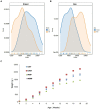Integrating microbial 16S rRNA sequencing and non-targeted metabolomics to reveal sexual dimorphism of the chicken cecal microbiome and serum metabolome
- PMID: 39101039
- PMCID: PMC11294938
- DOI: 10.3389/fmicb.2024.1403166
Integrating microbial 16S rRNA sequencing and non-targeted metabolomics to reveal sexual dimorphism of the chicken cecal microbiome and serum metabolome
Abstract
Background: The gut microbiome plays a key role in the formation of livestock and poultry traits via serum metabolites, and empirical evidence has indicated these traits are sex-linked.
Methods: We examined 106 chickens (54 male chickens and 52 female chickens) and analyzed cecal content samples and serum samples by 16S rRNA gene sequencing and non-targeted metabolomics, respectively.
Results: The cecal microbiome of female chickens was more stable and more complex than that of the male chickens. Lactobacillus and Family XIII UCG-001 were enriched in male chickens, while Eubacterium_nodatum_group, Blautia, unclassified_Anaerovoraceae, Romboutsia, Lachnoclostridium, and norank_Muribaculaceae were enriched in female chickens. Thirty-seven differential metabolites were identified in positive mode and 13 in negative mode, showing sex differences. Sphingomyelin metabolites possessed the strongest association with cecal microbes, while 11β-hydroxytestosterone showed a negative correlation with Blautia.
Conclusion: These results support the role of sexual dimorphism of the cecal microbiome and metabolome and implicate specific gender factors associated with production performance in chickens.
Keywords: cecal microbiota; chicken; integrated omics; serum metabolomics; sexual dimorphism.
Copyright © 2024 Yang, Zhang, Yu, Wang and Wang.
Conflict of interest statement
The authors declare that the research was conducted in the absence of any commercial or financial relationships that could be construed as a potential conflict of interest.
Figures






Similar articles
-
Microbiota and metabolome responses in the cecum and serum of broiler chickens fed with plant essential oils or virginiamycin.Sci Rep. 2020 Mar 25;10(1):5382. doi: 10.1038/s41598-020-60135-x. Sci Rep. 2020. PMID: 32214106 Free PMC article.
-
Integrated Analysis of the Effects of Cecal Microbiota and Serum Metabolome on Market Weights of Chinese Native Chickens.Animals (Basel). 2023 Sep 27;13(19):3034. doi: 10.3390/ani13193034. Animals (Basel). 2023. PMID: 37835639 Free PMC article.
-
The chicken cecal microbiome alters bile acids and riboflavin metabolism that correlate with intramuscular fat content.Front Microbiol. 2024 Dec 10;15:1494139. doi: 10.3389/fmicb.2024.1494139. eCollection 2024. Front Microbiol. 2024. PMID: 39720478 Free PMC article.
-
Cecal Microbial Succession and Its Apparent Association with Nutrient Metabolism in Broiler Chickens.mSphere. 2023 Jun 22;8(3):e0061422. doi: 10.1128/msphere.00614-22. Epub 2023 Apr 5. mSphere. 2023. PMID: 37017520 Free PMC article.
-
Florfenicol Enhances Colonization of a Salmonella enterica Serovar Enteritidis floR Mutant with Major Alterations to the Intestinal Microbiota and Metabolome in Neonatal Chickens.Appl Environ Microbiol. 2021 Nov 24;87(24):e0168121. doi: 10.1128/AEM.01681-21. Epub 2021 Oct 6. Appl Environ Microbiol. 2021. PMID: 34613752 Free PMC article.
References
-
- Cai Y., Weng K., Guo Y., Peng J., Zhu Z. J. (2015). An integrated targeted metabolomic platform for high-throughput metabolite profiling and automated data processing. Metabolomics 11, 1575–1586. doi: 10.1007/s11306-015-0809-4 - DOI
LinkOut - more resources
Full Text Sources

